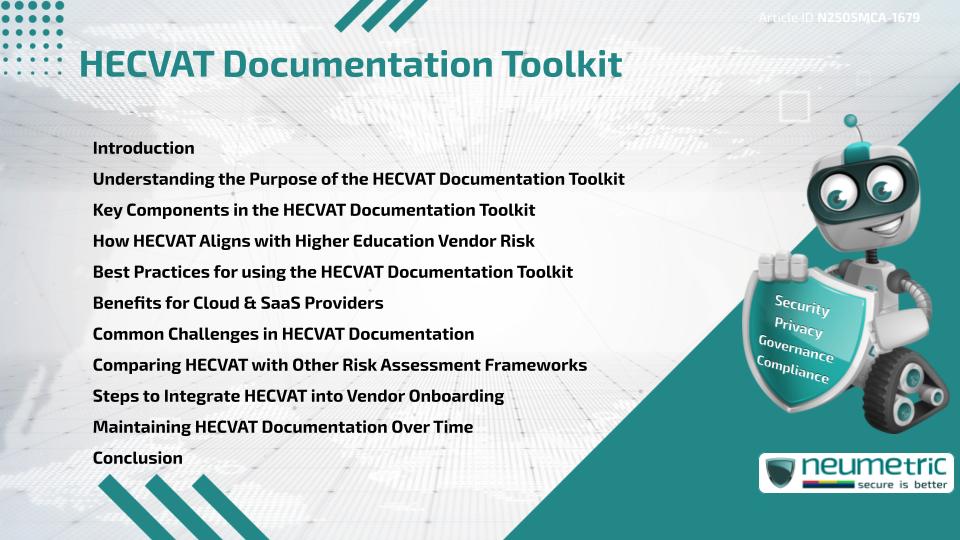Table of Contents
ToggleIntroduction
Colleges & Universities face growing pressure to manage Cybersecurity Risks, especially when working with Third Party Vendors. The HECVAT documentation toolkit offers a structured method to assess the security posture of Vendors & Service Providers. Developed by the Higher Education Community Vendor Assessment Toolkit [HECVAT] working group, this resource enables consistent evaluation of Cloud & SaaS Vendors that serve academic institutions.
In this article, we explore the structure, utility & implementation of the HECVAT documentation toolkit. We’ll also compare it with other Risk Assessment approaches, review common challenges & share practical tips for successful integration.
Understanding the Purpose of the HECVAT Documentation Toolkit
The HECVAT documentation toolkit was developed to help academic institutions identify & manage Vendor-related Cybersecurity Risks. As Cloud-based services became more common in education, there was a need to standardise how institutions questioned Vendors about Data Security & Compliance. The EDUCAUSE initiative led to the development of HECVAT with input from IT leaders across higher education.
Instead of each university creating its own questionnaires, the toolkit provides a central format to streamline the process. This helps save time & makes it easier for Vendors to respond accurately.
Key Components in the HECVAT Documentation Toolkit
The HECVAT documentation toolkit includes several templates & tools:
- HECVAT Full: A comprehensive set of questions used for detailed assessments.
- HECVAT Lite: A shorter version for low-Risk services.
- HECVAT On-Prem: For software installed on institutional systems.
- HECVAT Cloud Broker Index: Helps institutions manage Vendors offering multiple Cloud products.
These components ensure flexibility depending on the Risk level & deployment model. Institutions can choose the appropriate version to match their Risk tolerance & Vendor relationship.
How HECVAT Aligns with Higher Education Vendor Risk
In higher education, Vendors often handle Sensitive Data such as Student Records or research information. The HECVAT documentation toolkit ensures that these Vendors are properly vetted before contracts are signed. It addresses areas like:
- Access Controls
- Data Storage
- Encryption practices
- Incident Response readiness
This makes it easier for IT & legal teams to evaluate if a Vendor meets institutional requirements.
Best Practices for using the HECVAT Documentation Toolkit
To get the most out of the HECVAT documentation toolkit, institutions should consider the following:
- Centralise responsibility: Assign a team or role to manage Vendor assessments.
- Use Risk tiers: Match the toolkit version to the Vendor’s service Risk.
- Train staff: Make sure procurement & IT teams understand how to read & evaluate responses.
- Keep copies updated: Store completed assessments & periodically review them.
Creating a workflow that integrates HECVAT into procurement & IT Governance helps ensure consistent evaluations & better Vendor accountability.
Benefits for Cloud & SaaS Providers
Vendors also benefit from completing the HECVAT documentation toolkit. By submitting a completed form, they can:
- Reduce repetitive questionnaires from multiple institutions
- Speed up the procurement cycle
- Increase credibility with higher education customers
Common Challenges in HECVAT Documentation
Despite its usefulness, the HECVAT documentation toolkit has its share of hurdles:
- Time-consuming for small Vendors: Smaller companies may struggle to allocate resources to complete detailed assessments.
- Lack of awareness: Some institutions may not be familiar with HECVAT, causing inconsistencies in adoption.
- Over-scoping: Applying the full version when the lite version would suffice can lead to unnecessary burden.
It is essential to balance Risk with the level of effort required & offer support to Vendors new to the process.
Comparing HECVAT with Other Risk Assessment Frameworks
The HECVAT documentation toolkit differs from frameworks like NIST CSF or ISO 27001 by focusing more on Vendor questionnaires than internal controls. Unlike traditional audits, HECVAT relies on Vendor self-assessments, though some institutions may request Third Party validations.
While NIST or ISO frameworks are widely used in corporate sectors, HECVAT offers a tailored approach specific to academic environments. It complements those standards without replacing them.
Steps to Integrate HECVAT into Vendor Onboarding
Integrating the HECVAT documentation toolkit into Vendor onboarding involves these steps:
- Define when to trigger HECVAT: Set criteria based on data sensitivity or contract value.
- Select the right template: Choose full or lite based on Risk level.
- Request completion early: Ask Vendors to fill out HECVAT during the proposal phase.
- Review with a team: Include IT, legal & procurement staff in the review process.
- Archive results: Store in a Vendor management system or internal database.
Doing this ensures consistency & reduces delays in contract finalisation.
Maintaining HECVAT Documentation Over Time
Vendor Risk doesn’t end after onboarding. The HECVAT documentation toolkit should be part of ongoing reviews. Institutions should:
- Set review periods (e.g., annually)
- Re-assess after Security Incidents
- Track changes in Vendor offerings or data flows
Routine updates to HECVAT responses help ensure long-term Risk visibility.
Conclusion
The HECVAT documentation toolkit plays a critical role in strengthening Cybersecurity practices across the higher education sector. By offering a consistent, structured approach to Vendor Risk Assessments, it simplifies the process for institutions while promoting Transparency & Accountability from Vendors. Its flexibility through different formats—full, lite or on-prem—ensures it can be adapted to a wide range of service models & Risk levels.
While not without its challenges, especially for smaller Vendors or new adopters, the toolkit fills a crucial gap between procurement & Cybersecurity Governance. When used effectively, it not only protects sensitive institutional data but also fosters better collaboration between schools & their technology partners.
Ultimately, the toolkit represents more than just a questionnaire—it is a bridge between operational needs & security expectations in a digital education environment.
Takeaways
- The HECVAT documentation toolkit enables consistent Risk Assessments across higher education.
- Its structured templates save time & reduce redundant effort.
- Aligning HECVAT with procurement improves both security & Vendor relationships.
- Institutions should train staff & follow Best Practices to maximise its impact.
- Regular updates & reviews ensure documentation stays relevant.
FAQ
What is the HECVAT documentation toolkit used for?
It helps higher education institutions assess Third Party Vendor Risk by using a standardised security questionnaire.
Who created the HECVAT documentation toolkit?
The toolkit was developed by the EDUCAUSE community with support from Internet2 & the REN-ISAC consortium.
Is HECVAT mandatory for all Vendors?
No, but many institutions require it during procurement, especially if Sensitive Data is involved.
Difference between HECVAT Lite & HECVAT Full?
HECVAT Full is used for high-Risk services, while HECVAT Lite is designed for lower-Risk Assessments.
How often should HECVAT responses be updated?
At least annually or after any major change in service scope, Security Controls or incidents.
Can Vendors submit the same HECVAT to multiple schools?
Yes, the toolkit is designed to be reused across institutions to minimise duplication of effort.
Is HECVAT equivalent to SOC 2 or ISO 27001?
No. While it complements them, it is not a certification or Compliance Framework but a questionnaire-based assessment tool.
Do Vendors need to hire consultants to complete HECVAT?
Not necessarily. Most Vendors with a security team can complete the toolkit internally.
References
Need help?
Neumetric provides organisations the necessary help to achieve their CyberSecurity, Compliance, Governance, Privacy, Certifications & Pentesting goals.
Organisations & Businesses, specifically those which provide SaaS & AI Solutions, usually need a CyberSecurity Partner for meeting & maintaining the ongoing Security & Privacy needs & requirements of their Clients & Customers.
SOC 2, ISO 27001, ISO 42001, NIST, HIPAA, HECVAT, EU GDPR are some of the Frameworks that are served by Fusion – a centralised, automated, AI-enabled SaaS Solution created & managed by Neumetric.
Reach out to us!


